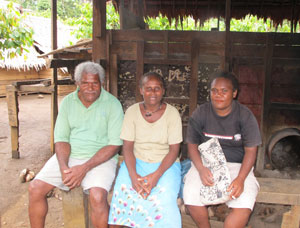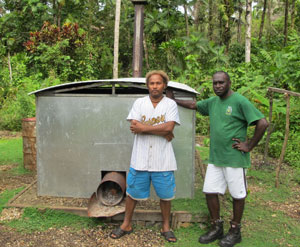There is often a story behind the neatly packaged chocolate bars we love to eat.
The story normally takes place on a small family cocoa farm in a tropical country. Often, it involves hardship. Pests and diseases destroy crops every year and the long, delicate process needed to help cocoa plants survive is a challenge.
Few people think about this as they bite into their favourite chocolate.
Cocoa farmer Moddy Tharetoona was only able to grow 150 cocoa trees on her small plantation in Solomon Islands. The income from this was barely enough for her family to survive. She made just enough money to buy soap and kerosene.
Throughout the 1980s thousands of farmers like Moddy planted cocoa trees in Solomon Islands, but they lacked some basic information on pruning and tree maintenance. Many trees grew too tall to be harvested properly and many died of disease.
Fortunately, the Cocoa Livelihoods Improvement Program has been teaching these farmers how to reduce the height of their trees and stimulate growth of new shoots and pods.
The Australian-funded program has now set up 53 demonstration sites across the country to show other farmers how to benefit from the farming methods and boost production.
Getting more bite out of farming
AusAID Program Manager Luke Simmons said the program is also teaching farmers to know what their costs are and offering advice about reinvesting profits in their farms so they become self-reliant. It is also helping farmers organise themselves into companies so they can form new contracts with overseas buyers.
'Cocoa processing involves fermenting wet cocoa beans and then drying them to add value before selling to cocoa buyers,' Mr Simmons said. 'The farmer training has helped improve fermentation and drying practices and the design of improved cocoa driers is ensuring the cocoa is not tainted by wood smoke.'
Mr Simmons said there are now many rehabilitated cocoa farms and new cocoa plantings popping up around demonstration sites, an indication the program is working.
Prior to the program, Eric Potale had no experience in processing cocoa and only had a small number of cocoa trees on his farm.
'I was interested in developing a business as a cocoa processor in my village, so the program supported me to buy a cocoa mini-drier and to attend training on cocoa fermentation, financial management and record keeping,' Mr Potale said.
'I am very happy with this. Now I am looking to plant more cocoa trees as well as buy wet cocoa beans from neighbouring farmers for processing.'
As for Moddy, thanks to her training, her cocoa farm has more than doubled after she pruned her old trees and planted another 300. She is now making enough money to pay her children's school fees and repair her house, significantly improving the lives of her family.


